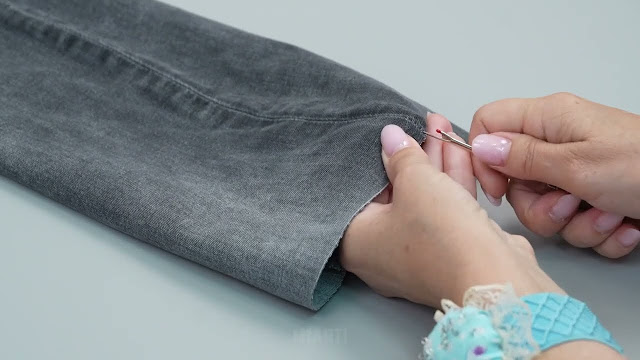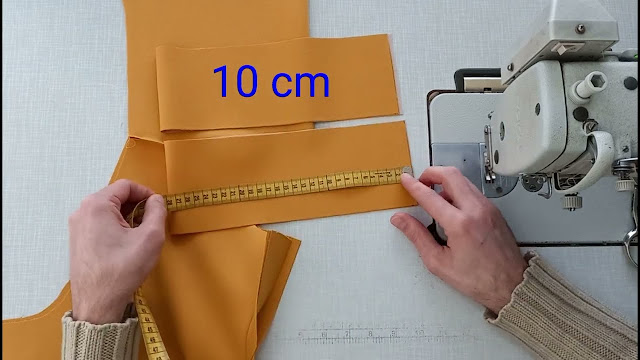Got a pair of jeans you love but don't wear anymore? Perhaps they're too tight in the legs, or you just fancy a change? Don't toss them! Give them a chic new life by transforming them into a trendy and versatile button-front pencil skirt, just like the one pictured above. This upcycling project is not only fantastic for the environment but also allows you to create a custom-fit skirt with that perfectly worn-in denim feel.
This tutorial will guide you through the process of deconstructing your jeans and reassembling them into a flattering, A-line or straight pencil skirt with a stylish button-front closure.
Why You'll Love This Project:
Eco-Friendly: Reduces textile waste by giving old jeans a stylish second life.
Budget-Friendly: Creates a brand-new garment without buying new fabric.
Custom Fit: Utilizes the perfect fit of your jeans' waistband and hip area.
Unique Style: Your skirt will have that authentic denim look with cool seam details.
Beginner-Friendly: A relatively straightforward project for those with basic sewing skills.
What You'll Need:
1 Pair of Adult Denim Jeans: Choose a pair that fits comfortably around your waist and hips, as this will form the top part of your skirt. Straight-leg or bootcut jeans often provide more fabric for the skirt panels.
Sewing Machine: Essential! Make sure you have a denim needle installed – it's crucial for stitching through thick denim seams.
Strong Polyester Thread: Matching your denim for invisible seams, or a contrasting color (like gold or orange) for topstitching that classic denim look.
Fabric Scissors: Sharp and sturdy for cutting denim.
Measuring Tape or Ruler.
Fabric Chalk or Washable Marker.
Pins.
Iron and Ironing Board.
Seam Ripper: Your best friend for this project!
Buttons: 4-7 buttons, depending on the length of your skirt and desired spacing. Consider metal jean buttons or shank buttons for an authentic look.
Optional: Lightweight fusible interfacing for the button placket.
Step-by-Step Pattern & Sewing Guide:
Step 1: Deconstruct Your Jeans
Lay your jeans flat: Smooth them out on a large work surface.
Open the inseams: Using your seam ripper, carefully unpick the inseams (the inner leg seams) from the crotch all the way down to the hem of both legs. This will allow you to flatten out each pant leg.
Open the crotch seam (front and back): Carefully unpick the curved crotch seam on both the front and back of the jeans. Open it up completely so that the front and back of the jeans are now separate pieces of fabric. Be careful not to unpick the zipper fly or the waistband area.
Press flat: Press all the deconstructed denim pieces flat to remove any creases.
Step 2: Create the Front Skirt Panel (Button Placket)
Overlap and Pin: Take the two front pieces of your jeans. Overlap the raw, curved edges of what was the crotch area. Pin them together, aiming to create a straight line down the center front. This new seam will form your button placket. The amount of overlap will determine how wide your placket is – aim for enough to accommodate your buttons (usually 1.5 to 2 inches / 3.8-5 cm for the total finished placket width).
Tip: If your jeans have a zipper fly, you can unpick the stitches that hold the zipper in place on one side, allowing the fabric to lay flatter for the overlap. You will not be reusing the zipper.
Stitch the Placket Base: Stitch this overlapped seam securely down the new center front. You can use a double line of stitching for strength. Trim any excess fabric from underneath.
Prepare for Buttons: If desired, you can add a strip of fusible interfacing to the wrong side of the newly formed placket area for added stability for your buttonholes.
Mark Buttonholes: Mark the placement for your buttonholes down the center front placket. Start from the existing waistband button, or just below it. Space them evenly down the length of the skirt.
Sew Buttonholes: Use your sewing machine's buttonhole foot to create the buttonholes. Carefully open them with a seam ripper.
Step 3: Create the Back Skirt Panel
Overlap and Stitch: Take the two back pieces of your jeans. Overlap the raw, curved edges of what was the back crotch seam. Pin them together to create a straight, continuous seam down the center back.
Stitch: Stitch this new seam securely down the center back. Trim excess fabric and press the seam open or to one side.
Topstitch (Optional but Recommended): For a professional, ready-to-wear look, topstitch on either side of your newly sewn front and back center seams. This mimics the original denim flat-felled seams and adds durability.
Step 4: Determine Skirt Length & Hem
Try on the skirt base: Put on the newly formed skirt.
Mark desired length: Stand in front of a mirror and mark your desired skirt length with chalk. Remember to add about 1 to 2 inches (2.5-5 cm) for your hem allowance.
Trim: Take the skirt off and carefully trim the bottom edge straight across at your marked line.
Hem the skirt: Fold the raw hem edge up by 1/2 inch (1.25 cm), press. Then fold up again by another 1 inch (2.5 cm) and press. Stitch the hem in place, using a double row of topstitching for a classic denim hem.
Step 5: Attach Buttons
Mark Button Placement: Place the side of the skirt with the buttonholes over the other front side, aligning the buttonholes. Use your fabric marker to mark the exact placement of each button through the buttonholes.
Sew Buttons: Stitch your buttons securely in place on the marked spots.
Your Stylish New Denim Skirt!
And there you have it! A chic and comfortable button-front pencil skirt, beautifully upcycled from a pair of your old jeans. This skirt is incredibly versatile – perfect for pairing with t-shirts, sweaters, or blouses for a casual yet put-together look.
We'd love to see your amazing denim transformations! Share your new skirts with us in the comments below or tag us on social media! Happy sewing!





















































